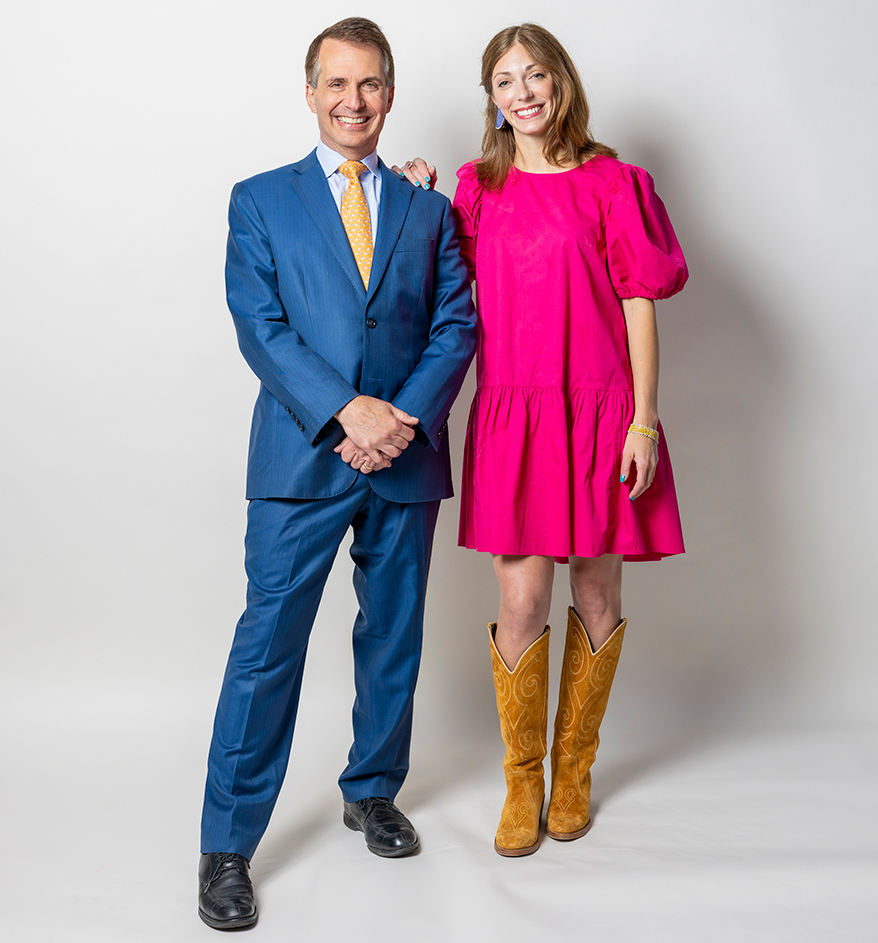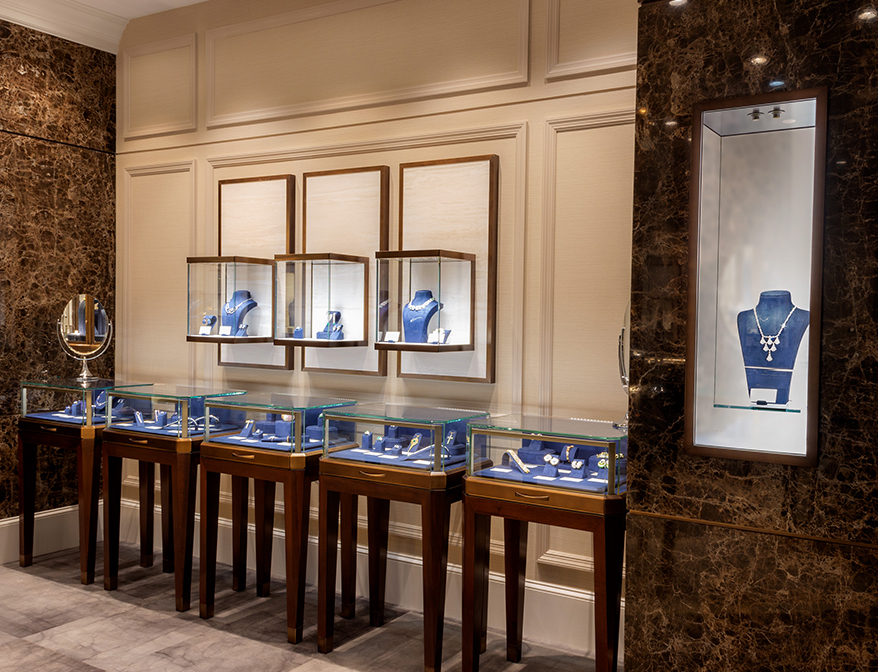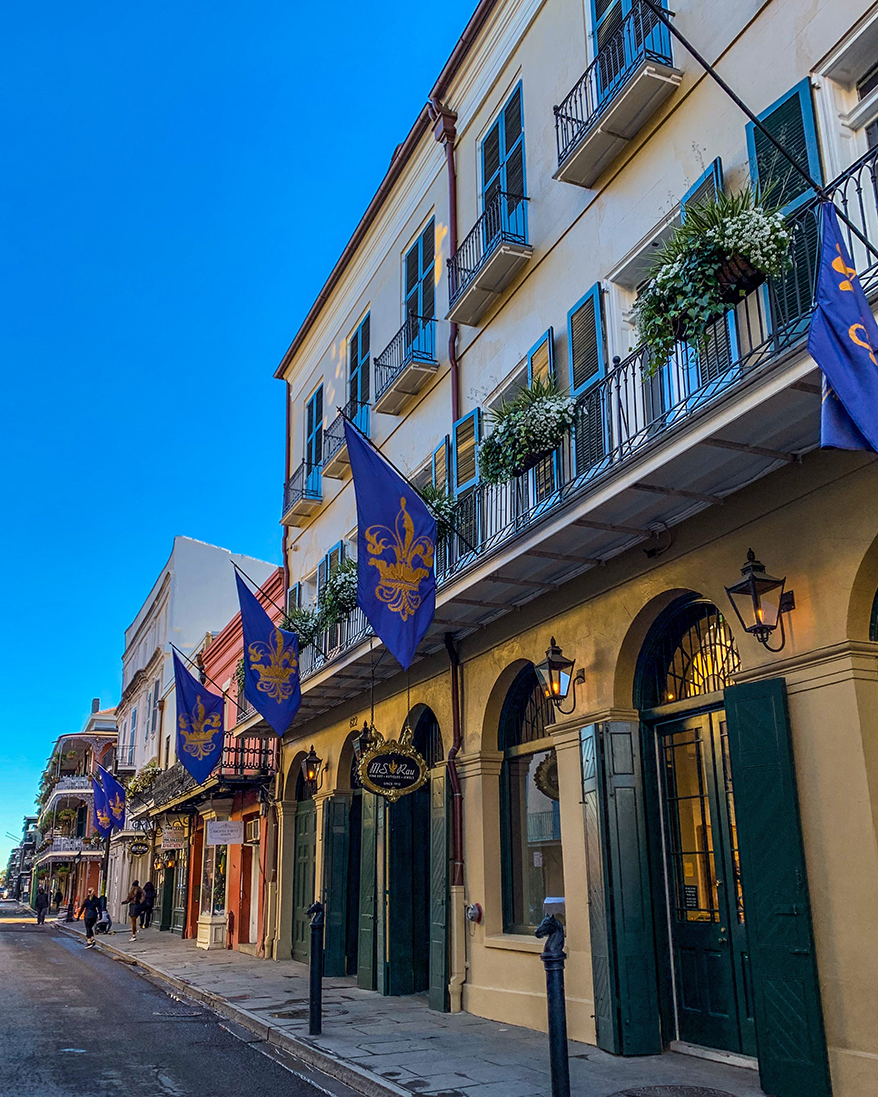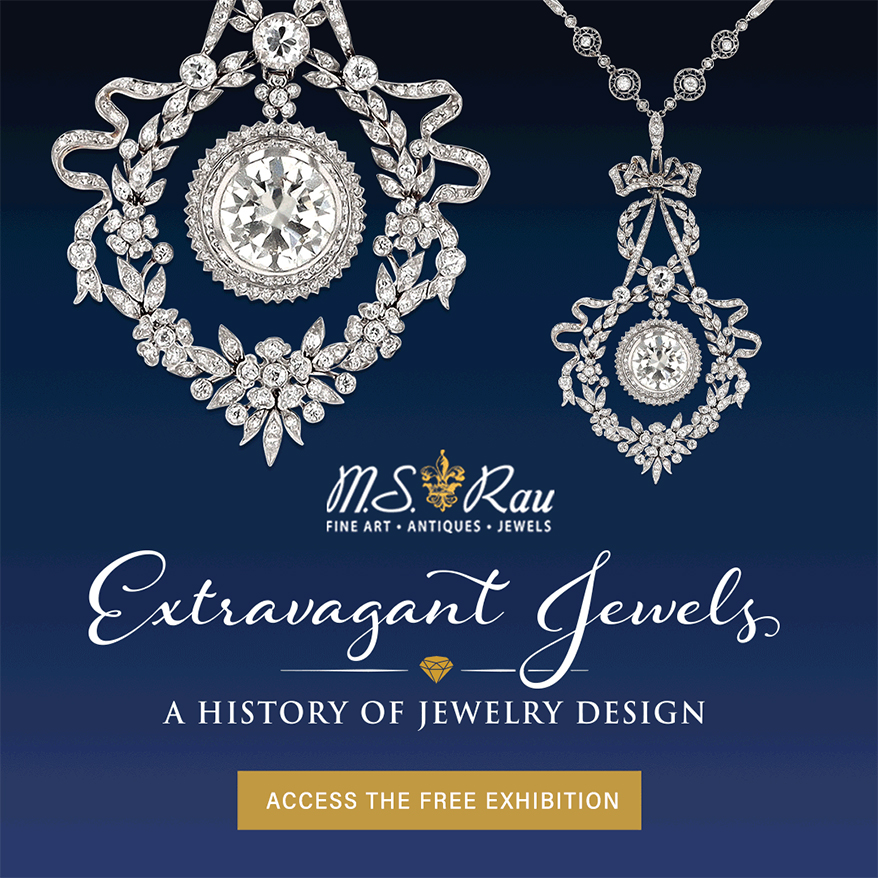M.S. Rau, New Orleans
OWNERS: Bill and Rebecca Rau; URL: msrau.com; FOUNDED: 1912; Renovated: 2021;OPENED FEATURED LOCATION: 2020; AREA: 40,000 square feet; ARCHITECT: Office of Jonathan Tate; DESIGNER: Trust Brand Design; SHOWCASES: Artco Group, Miami and D&Sign SLR, Milan; TOP BRANDS: JAR, Cartier, Tiffany & Co., Van Cleef & Arpels, Oscar Heyman, Harry Winston, Raymond Yard; EMPLOYEES: 70; ONLINE PRESENCE: 5 Stars on tripadvisor.com; 4.9 Star average for 347 Google reviews; Buildout cost: Multi-million dollar expansion and renovation in 2019 and in 2021
THREE DAYS BEFORE the M.S. Rau Jewelry Gallery on New Orleans’ gallery-lined Royal Street was due to open, 20 workers still bustled about, maneuvering ladders and drop cloths as they completed details on a deadline. Owner Bill Rau was in the midst of the fray, quickly making decisions so progress would continue apace.
The next day, though, when only a few workers remained, Bill was finally able to take it all in. “It was the first two hours we didn’t have ladders and drop cloths everywhere,” he recalls. “So, for the first time, I opened my eyes to everything. And a person who works here said, ‘This may be the most beautiful jewelry gallery I’ve ever seen in my life.’ I stepped back and looked around, really looked around for the first time, and said ‘Me, too.’ Up until then, we hadn’t seen it. But then I knew we had nailed it.”

In 2015, Bill bought two early 19th century properties adjacent to the original M.S. Rau site on Royal Street and embarked on a huge expansion, with plans to create a painting gallery and reimagine the jewelry gallery. The painting gallery, which opened in 2019, highlights rare work from important artists such as Monet, Bouguereau and Picasso, along with antiques of notable provenance, including Napoleon’s desk and a Tsar Nicolas II Winter Palace armoire. And although the painting gallery is three or four times larger than the jewelry gallery, it was the latter that turned out to be rife with the kind of complexities that led to a number of “gray hairs” for everyone involved.

Bill and Rebecca Rau; Photo: Chris Granger
The Jewelry Gallery space, the site of M.S. Rau since 1931, occupies a structure built centuries ago in the 300-year-old French Quarter. It had never been completely renovated. This renovation would go down to the dirt and out to the walls. And because it was eligible for tax credits, it was subject to rules set both by the state of Louisiana and the city park service. So certain features the design team wanted, like a coffered ceiling, weren’t possible, while things they didn’t want, like a second staircase, were required. Perhaps most challenging, they were faced with the reality that bulky columns were in fact structural, holding up the floor above. They couldn’t be removed.
Rebecca Rau, vice president of acquisitions and Bill’s daughter, found herself jumping back and forth between the mindset of perfectionism and the idea that “perfect is the enemy of good.”
“There were countless decisions, and it was tough to decide which to belabor and which to go with our immediate instincts,” she says. “Plus, we were juggling design and construction teams across the globe amid a pandemic while going through the permitting processes in a historic district. It was a lot!”

Curved showcases facilitate traffic flow around the Crystal Palace, a private meeting space.
When the team was divided, Bill would ask himself whose opinion he valued most in each situation. “It was rarely the same person,” he says. “The challenge was that it slowed down the process and cost a lot more money, but it came out a lot better. I didn’t want to settle for anything that wasn’t great. We wanted only things that were amazing. We wanted to surprise people.”
Rebecca says she was so busy that it took weeks for her to realize they’d pulled it off. “But once I was able to see more clearly, I was amazed,” she says. “I was able to let go of perfectionism by thinking back on our archive of historic photos of the place. I hate to admit it, but it looked like a glorified junk shop in this space for much of the early 20th century.
Advertisement
And now we’re a world-class boutique.”
In the end, they found the perfect solution to not only integrate those structural columns into the gallery’s aesthetic but make them look beautifully intentional by building display cabinets around them and masking them with the velvet used in the display case. A chandelier feature at the top ties the design together.

Each piece of jewelry is accompanied by an information card, many of which have QR codes.
Showcased jewelry shines inside custom-built Italian marble and walnut casework manufactured in Milan and furnished with silk.
An oval glass room, called the Crystal Palace, provides a private but transparent area for sales consultants to meet with clients. Staff can control lighting and access cases with an iPad; individual lights can be adjusted to present each jewel in its best light. Facing the exterior, two projection screens descend at night to display images and videos of their finest pieces and encourage passersby to return the next day.
Advertisement
Every Kind of Junk
M.S. Rau was founded 110 years ago by Bill’s grandfather, Max, who was famously frugal and blessed with an exceptionally good eye and strong work ethic. Max, who died when Bill was 5, sold cut glass, decorative ironwork, Victorian furniture and every kind of junk, even old mattresses, because in 1912, a used furniture store and an antique store were not mutually exclusive.
“My grandfather was not raised with money,” Bill says. “He just had a great eye.” Bill’s father, Joe, and uncle, Elias, worked alongside Max for a quarter of a century. Bill’s grandmother, Fanny, outlived her husband, Max, by 25 years and worked until she was 99 and a half. So change was incremental.

The entrance to M.S. Rau’s main gallery reveals its scope.
Bill, the youngest of Max’s four grandchildren, started working in the business when he was 14, earning $5 a day after school and $15 on Saturdays. “In junior high school, when I was a screw-off, I had all Cs except an A in history on one report card. History interested me.” By the time he’d started college, he knew he wanted to make M.S. Rau his career — but only after he fully realized there were not too many 5-foot-6 professional basketball players in the NBA. He returned to M.S. Rau full time with a degree in business from the University of Colorado. “By that time, my father and uncle could see that I needed to be the future of the business and they gave me a lot of leeway to do things, although not always without a lot of yelling,” he recalls.
Bill became president and CEO in 1995, instituting improvements at M.S. Rau that have put him on top of a multi-million-dollar operation. One of his goals from the beginning, even if subconsciously, was to bring order to chaos. When he was a kid, it was routine to sell 25 or 50 pieces to one individual during a single visit. “People stacked their homes with acquisitions,” he says. “Now, people would rather their homes looked like the store does now: airy and beautiful. You have to evolve. Whatever got you here is not going to get you there.”
Rebecca has a master’s degree from Sotheby’s Institute of Art, but her education started early. “She would go on buying trips with me to museums, and one of the things I always did in a museum is say, ‘Pick out your favorite painting.’ I would also pick out mine,” says Bill. “Then I would say, ‘Why is it your favorite?’ It trained her eye.”

Structural columns were incorporated into the interior design.
Bill’s favorite piece of jewelry inventory is a French royal necklace of Burma rubies and natural pearls set in rose gold and housed in a box inscribed, “Diamants de la Couronne.” It had belonged to Emperor Napoleon III and Empress Eugenie. “It’s not necessarily the prettiest, but it’s really cool,” says Rau, who explains that Tiffany acquired it at auction when Napoleon III was ousted by the Third French Republic government. The government sold off the jewels in 1887, fearing a return of the monarchy. You can’t be king, they reasoned, without a crown. “It represents the greatest collection of crown jewels ever to be sold,” Bill says. The story itself is a treasure.
Rebecca looks to acquire pieces that make an immediate impact due to extraordinary color, size, history or provenance. “We love rare colored gemstones like Russian alexandrites with amazing color change or stunning Padparadscha sapphires. But we also love anything that tells a story, like the Duchess of Windsor’s emerald and pink tourmaline brooch, Elvis’ gold watch, or our exquisite oversized Renaissance cameo pendant. We want to offer important pieces you wouldn’t expect to find all in one place that blow you away!”
In this rarefied selling space, the more expensive pieces sell faster, because expensive means it’s the best. “People are willing to pay for the best and aren’t always willing to pay for the second best,” Bill says.

M.S. Rau has been on its Royal Street block since 1931.
In the old days, Max fielded questions about authenticity armed with the confidence that comes with experience. Today, customers doubting provenance or authenticity are rare. “The pieces look the part,” Bill says. “With jewelry, when you see we have a 35-carat diamond and a Burma ruby and diamond necklace, that pays for credibility.”
It’s backed up with honesty about what is known and isn’t known. “I tell my sales team all the time, don’t BS,” Bill says. “You have a lot more credibility by saying, ‘I don’t know. Let me find out.’”
Along with scrupulous honesty, what hasn’t changed through generations is the hospitality dispensed with cheerful aplomb to everyone, be they a random tourist who’s wandered a block off Bourbon Street or a serious international collector with an appointment. “We’re Southerners,” Bill says. “I never like ringing a bell to get into someplace. We had a salesperson here who told me that his old boss used to tell him to look at people to see if they can afford to be here. I said if you ever do that HERE, it will be your last day here.”

The marketing team produces five to seven catalogs annually.
Five Cool Things About M.S. Rau
1. MARKETING REACH. The company advertises regularly in both the New York Times and Wall Street Journal. In 2021, they began including QR codes within these ads to better connect readers with their website. In the gallery, QR codes are displayed with most items, and nearly half of the jewelry pieces include video clips on the website. In addition, the marketing team of 12 produces five to seven catalogs annually.
2. WEBINAR SERIES. During the start of the Covid-19 pandemic, M.S. Rau launched its first webinar series called Bourbon with Bill, featuring owner Bill Rau. These quarterly webinars remain popular with both established clients and also people who are interested in learning more about their offerings.
3. BIRTHDAY BASH. To celebrate turning 110 this year, M.S. Rau is collaborating with jewelry designer Oscar Heyman, whose business also turns 110 years old this year, to create a one-of-a-kind collection.
Advertisement
4. MUSEUM QUALITY. Every year, M.S. Rau curates museum-quality exhibitions that are free and open to the public. The Crowning Jewels exhibit in 2021 showcased some of the most important names in jewelry design, including Harry Winston, Cartier and JAR, as well as some of the most noteworthy jewelry collectors of the 20th century, including the Duchess of Windsor and the Duchess of Alba.
5. HOUSE CALLS. M.S. Rau started to use a private jet in 2021 in order to better access and meet their clients’ needs around the U.S. It allows clients to try on jewelry in the comfort of their own homes.
PHOTO GALLERY (19 IMAGES)
JUDGES’ COMMENTS
- marc adwar:It’s like a museum.
- mitchell clark:The jewelry space transports us to another era with its elegant chandeliers, draping crystals, and fine Italian casework. Like the products they sell, this store is a work of art, and the storefront is true to the New Orleans tradition.
- lyn falk: Amazing story and business. Great 3-D tour of the store interior on the website. All-around elegance and attention to detail. And a private jet?
- jacqueline johnson:Wow! What an incredible store that offers a high-end experience in several categories.
Try This: Support Emerging Artists
When M.S. Rau turned 100, they launched the Rau for Art Foundation to promote the talent of the community’s emerging artists at the high school level by awarding their excellence in artistic achievement. Each year, Rau for Art awards three scholarships, ranging from $1,500 to $7,500.
Online Extra: Q&A with Bill Rau
Q. What have your biggest challenges been in your career and how did you meet them?
A. COVID was and is not pleasant. Hurricane Katrina was horrible.
If you think of all the decisions in life that sometimes take months or years to happen. Like, where are you going to live? Where are your parents going to live? Where are your kids going to go to school? How do you pay your employees? All of those decisions hit me within minutes of each other. The best advice I got when we were getting ready to have our first call after Katrina with all the coworkers, I still felt like I’d had 12 espressos. But a coworker looked at me and said, the team is looking to you for guidance. He was one thousand percent correct. So I said we’re going to pay everybody and open as soon as we could. I was positive that after paying people for a long period of time some people wouldn’t come back. But life moves on and we did the right thing. I would say as a leader in my time it was the biggest challenge we had. I wouldn’t wish it on my worst enemy. Yet if it is the worst thing that happens to me, I’ve lived a pretty charmed life.
Q. How do you know when to take a risk on a piece?
A. There’s no great dealer that doesn’t take risks. It’s impossible to be a great dealer without taking great risks. And the competitive side of me wants to be a great dealer. Jim, a salesperson who passed away a few years ago, said, `You know, Bill, the longer we talk about whether we should buy something the quicker it sells.’ If you’re going to sell me a 10 carat diamond it’s a no brainer. But if it’s a piece of jewelry with a history and it’s expensive, then I’ll ask the team about it. The average turnover is far quicker on the more expensive pieces. In our world, more expensive means it’s the best. People are willing to pay for the best and aren’t always willing to pay for the second best.”
Q. How do you deliver stellar customer service?
A. Each client is assigned a dedicated sales consultant who serves as their guide through our current offerings, answers their questions and provides expert advice. Not only can clients visit our expansive showroom of rare and one-of-a-kind gemstones, but we also visit clients around the U.S. and even internationally, bringing our jewelry and fine art selections into their homes for them to view in person. The majority of our rare diamonds and gemstones have been professionally graded and certified by one or more trusted gemological laboratories, including the GIA, EGL, AGL and Gubelin. We also provide insured overnight shipping and can ship jewelry items on approval before a client commits to purchase, and we offer sizing and adjustment services.
Q. What’s Cool About Your Customer Experience?
A. Our philosophy has always been to offer clients only the very finest antiques, works of art and jewelry and to back every transaction with the highest level of customer service. Earning trust and delivering the best is our top priority.
Q. How do you hire?
A. We look for two traits. We look for smart and we look for friendly. I hate snobs. And we’re lucky because a lot of people want to work here. For them it’s an ideal job. For me, too. The sales team is made up of individuals who are passionate about history, art and exceptional jewels. The team is supported with great benefits such as insurance, vacation, 401k, incentives and an on-site gym.
Q. Does M.S. Rau have much of an engagement ring business?
A. It’s not a business I want to be into,” Rau says. “There are so many stores that do it so well. We want to be the place you come after you get engaged. Finding old stones, old jewelry, signed pieces, that’s where our skill set is. That’s where we believe we can do it better than almost everybody else. We have a passion for finding and selling the best.
Q. What is the advantage of being located in New Orleans?
A. One of the advantages of being here 110 years is we have a long time to meet people from all over. A lot of people don’t know that up until the 1960s New Orleans was the biggest city in the South, the financial powerhouse and also the shopping center. And so, when you couldn’t get something where you lived, you came to New Orleans for it. We built up a lot of good clients and good clients’ families over the years. We’re also fortunate because if we were in San Francisco or New York or LA, we couldn’t exist. We have 45,000 square feet here in the middle of the French Quarter where a ton of people walk past us all the time, and we can afford to have a building like ours. We couldn’t exist in other places.
Q&A with Rebecca Rau
Q. When did you first realize you had an interest in art history, jewelry and the family business?
A. I’ve always had a keen eye for aesthetics. My mother pushed me to consider fashion as a career avenue from a young age due to my unexpected fashion choices. Considering fashion design ultimately led to an interest in drawing and fine art, as well as art and jewelry history. I wasn’t always certain that I wanted to join the business – it was in my 20’s that I took a hard look in the mirror and admitted to myself how closely aligned my interests were with the business. At that stage, I realized it would be too great an opportunity to pass up and pursued a master’s degree that would prepare me to (re)join M.S. Rau.
Q. What kind of jewelry do you like to wear personally or collect?
A. Because we deal in antiques as well as jewelry, I am often drawn to jewelry featuring semi-precious hardstones like banded agate or lapis. They feel familiar thanks to having seen them in so many forms – like objets d’art and furniture.
Q. Bill explained how when the two of you visited museums he would ask you to pick out your favorite piece, and then ask you why? What was that experience like for you, and what else went into developing your “eye?”
A. love to get lost in museums and often visit them alone while traveling. Spending countless hours in museums has certainly helped develop my eye, but it was enriching growing up with a father who could contextualize objects historically for me. My father has an amazing knowledge of history, even though he used to embarrass my sister and me by routinely correcting museum docents when we traveled as kids.
Q. What do you like best or think is most impressive about the completed Jewelry Gallery project?
A. Technically speaking, the round glass room, our “crystal palace” is a feat, not to mention an amazing place to display our top jewels of provenance and significance. Functionally speaking though, it’s also such a relief to finally have a walk-in safe!
Q. What aspect of the business intrigues you the most at this point in your life and career?
A. I am most interested in educating our clients on what make jewelry, fine art and antiques truly great (and valuable). I believe in collecting from a place of passion and interest more so than status, which I hope in turn will encourage people to grow their collections beyond the expected.